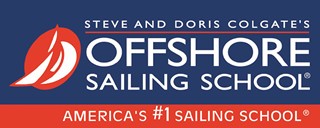Rudderless Drill
Reprinted from “Fundamentals of Sailing, Cruising, & Racing” by Steve Colgate; published by W.W. Norton & Co.
Another drill one hopes never to have to use is sailing without a rudder. Though you may sail 20 years without losing your rudder at sea, it could happen your first time out. You can control the direction of the boat by changing the efficiency of the sails fore and aft. By luffing the jib and trimming the main, we create weather helm and the boat turns into the wind. By luffing the main and flattening the jib, the wind pushes the bow to leeward – in other words, lee helm. To practice this, trim your jib reasonably flat and ease your mainsail until the boat is balanced and sails straight ahead when the helm is released. Then change your course by trimming the main to head up and pushing the boom out to fall off. When the bow starts swinging in one direction, you must immediately begin the opposite procedures to counteract the swing.
In order to tack, free the jib sheets and trim in the mainsail hard and fast. As soon as the boat is past head-to-wind, trim the jib and ease the main to force the bow down. If necessary, back the jib.
Jibing is much more difficult to do without the rudder because the mainsail causes the boat to turn toward the wind when running. To try it, ease the main completely, making sure the boom vang is also loose, and back the jib to windward. As you fall off to a run, move all the crew to the windward side of the boat and hike out. By heeling the boat to weather, lee helm should be created. Just as a bow wave on the lee side pushes a heeling boat to weather, a bow wave on the windward side (caused by healing the boat to windward) pushes the bow to leeward. In this case, we are using crew weight to help a rudderless jibe, but at other times crew members hike out to weather, not only when closehauled, but on reaches and runs to reduce weather helm.
If the breeze is very light, we can make minor adjustments to the helm by moving the crew weight forward and aft. With the boat balanced as described above, move the crew well forward toward the bow. The boat will head into the wind as the curve of the bow bites more deeply into the water. By moving the crew to the stern, the bow will fall off to leeward.
We hope you found our advice on how to sail without a rudder helpful. Happy Sailing from Steve Colgate, founder of Offshore Sailing School!

